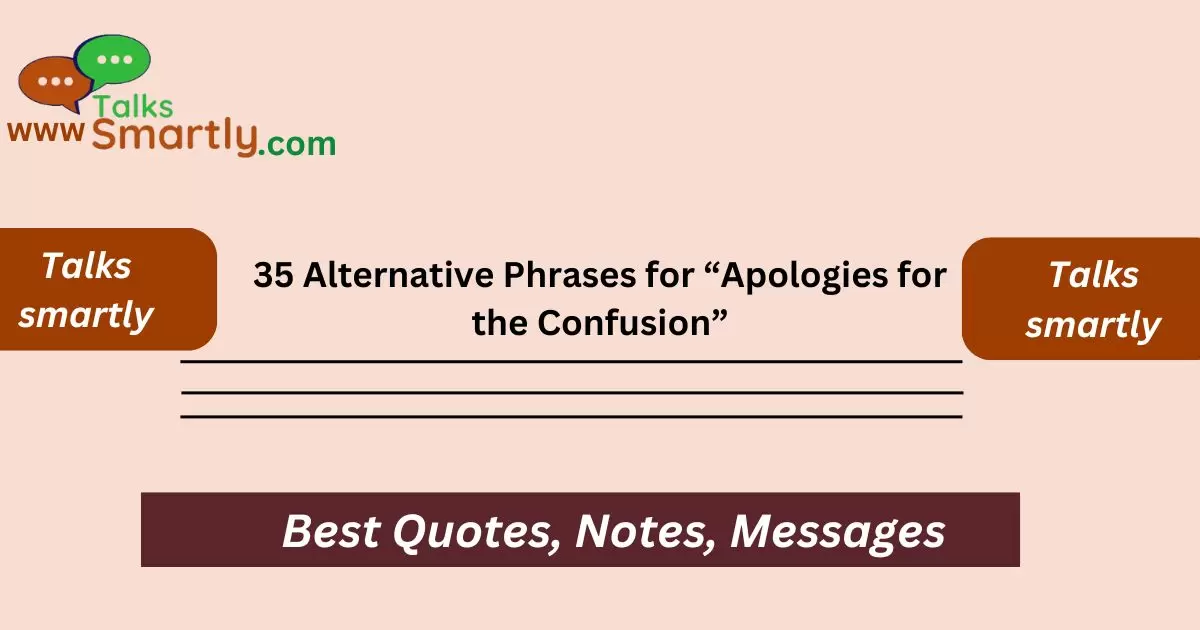“Finding the right way to apologize can turn a misunderstanding into an opportunity for better communication.”
When you’ve caused confusion, offering a sincere apology is essential for clearing the air and restoring clarity. Saying “Apologies for the confusion” is a common approach, but there are many alternative phrases that can convey your message more effectively or suit different situations. Using varied expressions can help tailor your apology to the context and your relationship with the person you’re addressing.
Whether you’re dealing with a professional setting, a personal misunderstanding, or just trying to smooth things over, choosing the right words can make all the difference. This blog post will explore a range of alternative phrases you can use to apologize for confusion, each with its own nuance and application.
35 Alternative Phrases for “Apologies for the Confusion”
- I’m sorry for any misunderstanding.
- My apologies for any confusion caused.
- I regret any mix-up.
- Please excuse any confusion.
- I appreciate your patience with this issue.
- Sorry for the lack of clarity.
- I apologize for any unclear communication.
- I understand if there was any confusion.
- I regret any miscommunication.
- Thank you for your understanding regarding this matter.
- I’m sorry if this caused any confusion.
- I apologize for the oversight.
- I hope this clears things up.
- I appreciate your patience as we sort this out.
- I’m sorry for any misunderstanding on my part.
- I apologize if this was not communicated clearly.
- Thank you for bearing with me.
- I regret any confusion this may have caused.
- Sorry for any inconvenience caused.
- I hope this resolves any confusion.
- I’m sorry for any mix-up.
- Please let me know if there are any further questions.
- I’m sorry if this was unclear.
- My apologies for any errors in communication.
- I appreciate your understanding of this situation.
- I regret any confusion stemming from this.
- Sorry for any errors or misunderstandings.
- I hope this explanation clears things up.
- I’m sorry if I wasn’t clear.
- Thank you for your patience with this matter.
- I apologize if there was any misunderstanding.
- I’m sorry for any miscommunication.
- I appreciate your patience as we work through this.
- I’m sorry if this has caused any confusion.
- I hope this addresses any issues.
1. I’m sorry for any misunderstanding.
This phrase is straightforward and conveys a general apology for any misinterpretation.
Example: “I’m sorry for any misunderstanding regarding the project details. Let’s clarify things.”
2. My apologies for any confusion caused.
A formal way to acknowledge and apologize for the confusion.
Example: “My apologies for any confusion caused by the changes in the schedule. I’ll make sure to update everyone promptly.”
3. I regret any mix-up.
This phrase expresses regret about a specific mix-up that occurred.
Example: “I regret any mix-up with the meeting times. Let’s set a new schedule that works for everyone.”
4. Please excuse any confusion.
A polite way to ask for forgiveness for any confusion that may have occurred.
Example: “Please excuse any confusion from the email. I’ll resend the correct information.”
5. I appreciate your patience with this issue.
Acknowledges the other person’s patience while addressing the confusion.
Example: “I appreciate your patience with this issue. I’m working to ensure it doesn’t happen again.”
6. Sorry for the lack of clarity.
Acknowledges that the original message or information wasn’t clear.
Example: “Sorry for the lack of clarity in the report. I’ll provide a detailed explanation.”
7. I apologize for any unclear communication.

A more formal way to address any issues with communication.
Example: “I apologize for any unclear communication about the deadlines. I’ll make sure to provide more precise information.”
8. I understand if there was any confusion.
Acknowledges that the confusion is understandable.
Example: “I understand if there was any confusion about the process. Let’s go over the steps together.”
9. I regret any miscommunication.
Expresses regret for any miscommunication that occurred.
Example: “I regret any miscommunication regarding the project scope. Let’s discuss how we can move forward.”
10. Thank you for your understanding regarding this matter.
Thanks the person for their understanding while addressing the confusion.
Example: “Thank you for your understanding regarding this matter. I’ll ensure better communication in the future.”
11. I’m sorry if this caused any confusion.
A way to apologize specifically if the situation led to confusion.
Example: “I’m sorry if this caused any confusion about the assignment. I’ll clarify the details immediately.”
12. I apologize for the oversight.
Acknowledges a specific oversight that led to confusion.
Example: “I apologize for the oversight in the instructions. I’ll correct the error and update you.”
13. I hope this clears things up.
Aims to provide clarity and resolve the confusion.
Example: “I hope this clears things up about the new policy. Please let me know if you have any more questions.”
14. I appreciate your patience as we sort this out.
Thanks the person for their patience while resolving the issue.
Example: “I appreciate your patience as we sort this out. I’ll keep you updated on the resolution.”
15. I’m sorry if this was not communicated clearly.
Apologizes for any lack of clarity in communication.
Example: “I’m sorry if this was not communicated clearly. I’ll ensure the message is more precise next time.”
16. I apologize for any misunderstanding on my part.
Acknowledges that the misunderstanding was on your side.
Example: “I apologize for any misunderstanding on my part regarding the report details. I’ll correct it immediately.”
17. Thank you for bearing with me.
Shows appreciation for the person’s patience and understanding.
Example: “Thank you for bearing with me while I sorted out the issue. I appreciate your patience.”
18. I regret any confusion this may have caused.
Expresses regret specifically about the confusion caused.
Example: “I regret any confusion this may have caused with the schedule changes. I’ll ensure clear updates moving forward.”
19. Sorry for any inconvenience caused.
Apologizes for any inconvenience resulting from the confusion.
Example: “Sorry for any inconvenience caused by the mix-up. I’ll make sure it doesn’t happen again.”
20. I hope this resolves any confusion.
Aims to address and resolve the confusion.
Example: “I hope this resolves any confusion about the project timeline. Let me know if there are further concerns.”
Encouraging Words for Someone Studying
21. I’m sorry for any mix-up.
Acknowledges and apologizes for a mix-up that occurred.
Example: “I’m sorry for any mix-up with the delivery schedule. I’ll ensure the correct timing is communicated.”
22. Please let me know if there are any further questions.
Invites further questions to clear up any remaining confusion.
Example: “Please let me know if there are any further questions about the procedure. I’m here to help.”
23. I’m sorry if this was unclear.
Apologizes specifically for any lack of clarity.
Example: “I’m sorry if this was unclear regarding the assignment details. I’ll provide more information.”
24. My apologies for any errors in communication.
A formal apology for any communication errors.
Example: “My apologies for any errors in communication about the meeting agenda. I’ll make sure to provide accurate details.”
25. I appreciate your understanding of this situation.
Thanks the person for understanding the situation.
Example: “I appreciate your understanding of this situation and your patience as we work through it.”
26. I regret any confusion stemming from this.
Expresses regret about confusion arising from the situation.
Example: “I regret any confusion stemming from the policy update. I’ll clarify the changes.”
27. Sorry for any errors or misunderstandings.
Acknowledges and apologizes for errors and misunderstandings.
Example: “Sorry for any errors or misunderstandings regarding the project details. I’ll correct them immediately.”
28. I hope this explanation clears things up.
Provides an explanation with the aim of resolving confusion.
Example: “I hope this explanation clears things up about the new procedure. Please let me know if you need more details.”
29. I’m sorry if I wasn’t clear.

Apologizes specifically for a lack of clarity on your part.
Example: “I’m sorry if I wasn’t clear about the deadlines. I’ll provide a detailed schedule.”
30. Thank you for your patience with this matter.
Shows appreciation for the person’s patience while resolving the issue.
Example: “Thank you for your patience with this matter. I’m working to ensure better communication moving forward.”
31. I apologize if there was any misunderstanding.
Apologizes if there was any misunderstanding.
Example: “I apologize if there was any misunderstanding about the meeting agenda. Let’s review it together.”
32. I’m sorry for any miscommunication.
Acknowledges and apologizes for any miscommunication.
Example: “I’m sorry for any miscommunication about the project requirements. I’ll make sure to clarify.”
33. I appreciate your patience as we work through this.
Thanks the person for their patience while resolving the confusion.
Example: “I appreciate your patience as we work through this issue. I’m here to answer any further questions.”
34. I’m sorry if this has caused any confusion.
Apologizes if the situation has led to confusion.
Example: “I’m sorry if this has caused any confusion regarding the changes in procedure. I’ll provide a clear update.”
35. I hope this addresses any issues.
Aims to address and resolve any issues related to the confusion.
Example: “I hope this addresses any issues with the project timeline. If there’s anything else, let me know.”
ANSWER TO KEY QUESTION
1. What’s the best way to apologize for confusion in a professional setting?
Use formal phrases like “I apologize for any unclear communication” or “My apologies for any confusion caused” to maintain professionalism.
2. How can I apologize for confusion in a personal context?
Opt for phrases that are straightforward and sincere, such as “I’m sorry for any misunderstanding” or “Sorry for the mix-up.”
3. Is it important to provide an explanation when apologizing for confusion?
Yes, providing a brief explanation helps clarify the situation and shows that you’re taking steps to prevent similar issues in the future.
4. How can I ensure my apology for confusion is effective?
Be clear, concise, and sincere. Make sure to address the specific issue and offer a solution or clarification.
5. Can I use these phrases in written communication?
Yes, these phrases are suitable for both verbal and written communication, including emails and messages.
Conclusion
Offering an apology for confusion is crucial in maintaining effective communication and relationships. By using these alternative phrases, you can tailor your apology to the situation and convey your message clearly and thoughtfully. Whether in a professional or personal context, choosing the right words helps address misunderstandings and fosters better interactions.












